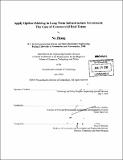Apply option-thinking in long term infrastructure investment : the case of commercial real estate
Author(s)
Zhang, Na, S.M. Massachusetts Institute of Technology
DownloadFull printable version (20.64Mb)
Other Contributors
Massachusetts Institute of Technology. Technology and Policy Program.
Advisor
Richard de Neufville.
Terms of use
Metadata
Show full item recordAbstract
Over the last two decades the application of real options theory has dramatically altered the way researches model infrastructure investment decisions. Real options are the right, but not obligation to do something for a certain cost within or at a specific period of time. Compared to the rich literature, its implementation in practice is however limited. This thesis identifies a common but ignored problem of the option valuation methodology. While trends and volatilities of market-based uncertainties are fundamental inputs for options valuation, they are in many cases difficult to get reliable estimates due to the changing patterns of the uncertainty factors. Current research on option valuation typically extracts estimates from data of a certain period (such as 10 years) without verifying the chosen period is superior to others. This thesis demonstrates this problem by analyzing the prices indices of underlying assets in real estate markets of U.S. and Singapore; and then shows how to adjust the flexibility design and valuation in long-term infrastructure development to capture the value of embedded options. Since uncertainty is the key driver of option value, the study of uncertainty itself should always be at the core of flexibility design. An in-depth study of (a) both the feature/nature of each uncertainty (b) and interactions among different uncertainties, inside and outside of the project/investment is essential and extremely important to give rise to attractive real options. This thesis looks at a sub-part of long-term infrastructure development - commercial real estate - which is usually high-rise building existing in a highly volatile market. An option-thinking approach is proposed to guide flexibility design, both inactive and proactive flexibility. Proactive flexibility gives rise to an infrastructure design that makes sense for both now and the future. This happens when the design use uncertainties, not the requirements from the user meeting, as one of the primary drivers of the design. The approach involves three aspects: financial, technical and political. Particularly, the political aspect indicates that developers should carefully form contracts with partners/customers as well as relevant authorities to make it possible to exercise the options in the future when desirable. This thesis uses a true case of mixed use commercial real estate development - Central in Singapore - to show the process of utilizing option-thinking in flexibility design and valuation.
Description
Thesis (S.M. in Technology and Policy)--Massachusetts Institute of Technology, Engineering Systems Division, 2010. Cataloged from PDF version of thesis. Includes bibliographical references (p. 111-115).
Date issued
2010Department
Massachusetts Institute of Technology. Engineering Systems DivisionPublisher
Massachusetts Institute of Technology
Keywords
Engineering Systems Division., Technology and Policy Program.